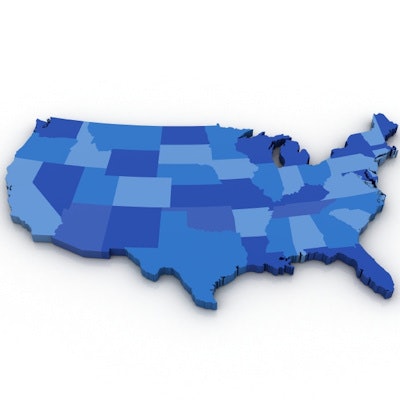
Where are the periodontists? As the number of people with periodontitis continues to increase in the U.S., are periodontal specialists located where they're most needed? To find out, researchers examined the geographic proximity of periodontal offices throughout the U.S. to the homes of the people who need their care.
Researchers examined the percentage of adults, in particular those with severe periodontitis, within various distances of a periodontist as well as the distribution of periodontists in relation to the density of those requiring their services. They unexpectedly found that areas with population densities between urban and rural levels had the lowest proximity to a periodontist. Their report was published in the Journal of the American Dental Association (November 20, 2018).
"Geographic proximity to specialized periodontal care may vary widely by locality," wrote the authors, led by Paul Eke, PhD, MPH, a senior health scientist at the Centers for Disease Control and Prevention in Atlanta.
Clustering common
Among dentate adults ages 30 and older in the U.S., 47% have periodontitis, according to the National Health and Nutrition Examination Survey (NHANES), and almost 9% of this group has severe periodontitis. Additionally, periodontitis affects 68% of the dentate U.S. population ages 65 and older, among whom 11% have severe disease, according to previous research.
“Geographic proximity to specialized periodontal care may vary widely by locality.”
The number of people with severe periodontitis continues to increase due to population growth and aging, as well as greater retention of natural teeth, the authors of the current study noted. However, they were aware of no previous research on the relationship of the location of periodontal offices to the homes of U.S. adults with severe periodontitis. To learn more, they analyzed the geospatial distribution of these factors in relation to each other.
Using the National Provider Identifier Registry, they identified all periodontists with practice addresses in the U.S. They also obtained from the 2010 U.S. Census population counts for each census block, the smallest census geographic unit. Each block is identified as belonging to either an urbanized area (multiple census blocks with a combined population of at least 50,000), an urban cluster (multiple blocks with a combined population of 2,500 to 49,999), or a rural area (remaining blocks).
The investigators used block-level data to calculate the number of adults ages 30 to 79 living within and outside of each periodontist's catchment area to estimate the population shared within overlapping catchment areas for multiple periodontists and to combine data for larger geographic units.
They also used data from NHANES, the Behavioral Risk Factor Surveillance System, and the American Community Survey to estimate the number of adults with severe periodontitis in each county nationwide, and they calculated Euclidean (straight-line) distance for each periodontist for various distances.
The researchers identified 5,415 periodontists practicing in 4,124 locations. Of these, almost 45% operated solo practices, and just over 49% were in group practices. In terms of location, 96% worked in urban areas clustered on the East Coast and West Coast, as well as in the Midwest; 3.1% were in urban clusters, and 0.8% were in rural areas.
The Northeast, central East Coast, Florida, West Coast, Arizona, and Midwest had clusters of communities with ratios of one periodontist to fewer than 8,000 adults with severe periodontitis within a 10-mile radius, while those with ratios of one periodontist to fewer than 8,000 adults with severe periodontitis within 50 miles were dispersed throughout the country, including in central states and counties.
Almost 70% of U.S. adults ages 30 to 79 lived in urban areas, 9.1% in urban clusters, and 21.1% in rural areas, the researchers reported. See the table below for the distance from a periodontist based on geographic location.
| Distance from a periodontist in the U.S. based on geographic location | |||
| Rural area | Urban area | Overall | |
| 5-mile radius | 7% | 81% | 60% |
| 10-mile radius | 24% | 95% | 73% |
| 20-mile radius | 54% | 99% | 85% |
| 50-mile radius | 91% | 100% | 97% |
Calculation limitations
The researchers noted that limitations to their calculations include the following:
- Use of straight-line distance as a proxy for travel distance may have overestimated periodontal accessibility in rural or mountainous areas.
- National Provider Identifier data may have over- or underestimated the number of periodontal practices, in part, because the data allowed only one practice location per practitioner and did not provide information on time spent on providing care.
- The model used has not been validated at the state and local levels.
Future research may include overlaying geospatial data with socioeconomic status in population clusters to determine the availability of periodontists for those most likely to need them, the authors noted.
"The findings from this study can provide information for statewide and local oral health programs about areas presenting potential challenges regarding access to specialist periodontal care because of reduced proximity to a periodontal practice," they concluded.



















